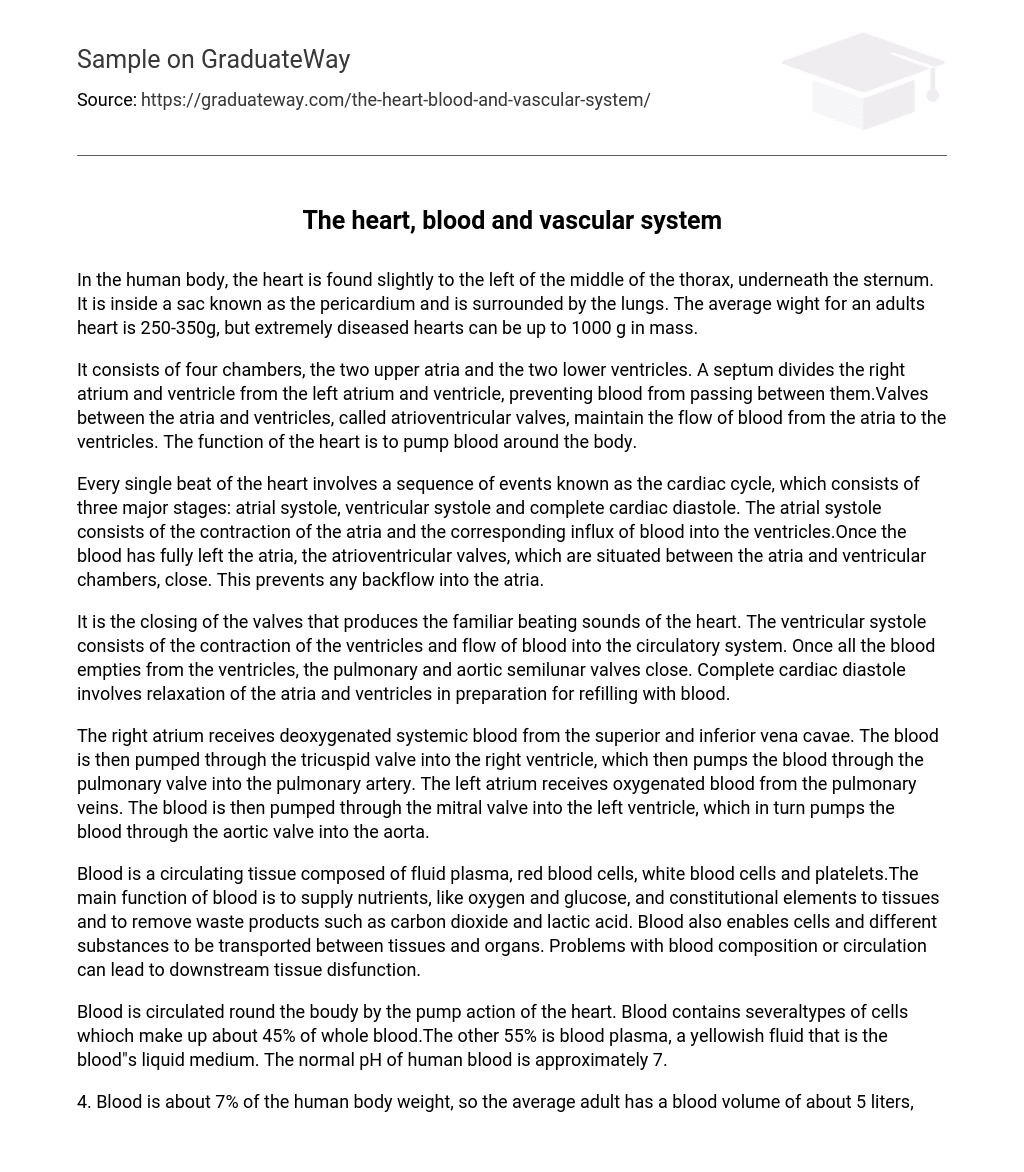In the human body, the heart is found slightly to the left of the middle of the thorax, underneath the sternum. It is inside a sac known as the pericardium and is surrounded by the lungs. The average wight for an adults heart is 250-350g, but extremely diseased hearts can be up to 1000 g in mass.
It consists of four chambers, the two upper atria and the two lower ventricles. A septum divides the right atrium and ventricle from the left atrium and ventricle, preventing blood from passing between them.Valves between the atria and ventricles, called atrioventricular valves, maintain the flow of blood from the atria to the ventricles. The function of the heart is to pump blood around the body.
Every single beat of the heart involves a sequence of events known as the cardiac cycle, which consists of three major stages: atrial systole, ventricular systole and complete cardiac diastole. The atrial systole consists of the contraction of the atria and the corresponding influx of blood into the ventricles.Once the blood has fully left the atria, the atrioventricular valves, which are situated between the atria and ventricular chambers, close. This prevents any backflow into the atria.
It is the closing of the valves that produces the familiar beating sounds of the heart. The ventricular systole consists of the contraction of the ventricles and flow of blood into the circulatory system. Once all the blood empties from the ventricles, the pulmonary and aortic semilunar valves close. Complete cardiac diastole involves relaxation of the atria and ventricles in preparation for refilling with blood.
The right atrium receives deoxygenated systemic blood from the superior and inferior vena cavae. The blood is then pumped through the tricuspid valve into the right ventricle, which then pumps the blood through the pulmonary valve into the pulmonary artery. The left atrium receives oxygenated blood from the pulmonary veins. The blood is then pumped through the mitral valve into the left ventricle, which in turn pumps the blood through the aortic valve into the aorta.
Blood is a circulating tissue composed of fluid plasma, red blood cells, white blood cells and platelets.The main function of blood is to supply nutrients, like oxygen and glucose, and constitutional elements to tissues and to remove waste products such as carbon dioxide and lactic acid. Blood also enables cells and different substances to be transported between tissues and organs. Problems with blood composition or circulation can lead to downstream tissue disfunction.
Blood is circulated round the boudy by the pump action of the heart. Blood contains severaltypes of cells whioch make up about 45% of whole blood.The other 55% is blood plasma, a yellowish fluid that is the blood”s liquid medium. The normal pH of human blood is approximately 7.
4. Blood is about 7% of the human body weight, so the average adult has a blood volume of about 5 liters, of which 2. 8 liters is plasma. The combined surface area of all the red blood cells in the human anatomy would be roughly 2000 times as great as the body”s exterior surface.
Blood cells generally live for upto 120 days before they are replaced by new ones formed in the bone marrow, by a process called hematopoiesis.Under normal conditions in humans, hemoglobin in blood leaving the lungs is about 97% saturated with oxygen, deoxygenated blood returning to the lungs is still approximately 75% saturated. All veins and arteries follow the same biological srtucture. The inner lining is the endothelium, followed by subendothelial connective tissue.
Then follows a muscular layer of vascular smooth muscle, which is highly developed in arteries. Finally, there is a further layer of connective tissue termed the adventitia, which contains nerves that supply the muscular layer, as well as nutrient capillaries in the larger blood vessels.Capillaries themsleves consist of little more than a layer of endothelium and occasional connective tissue. Blood vessels do not actively take part the transport of the blood but arteries, and also veins slighlty, can regulate their pressure by contraction of the muscular layer.
This determines the blood flow to particular downstream organs, and is determined by the autonomic nervous system. Vasoconstriction is the constriction of blood vessels ,narrowing, becoming smaller in cross-sectional area, which is done by contracting the vascular smooth muscle in the vessel walls.It is regulated by vasoconstrictors, which are chemicals that cause vasoconstriction. These include paracrine factors like a chemicle called prostaglandins a number of hormones like adreneline.
Blood vessels play a role in virtually every medical condition. Cancer, for example, cannot progress if the tumor does not cause formation of new blood vessels to supply the malignant cells” metabolic demand. Atherosclerosis, the formation of lumps of fat in the blood vessel wall, is the prime cause of cardiovascular disease, which is the main cause of death in the Western world.





